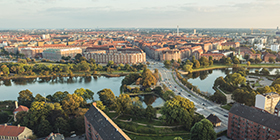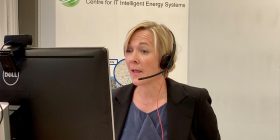The solution “Smart Temperature Control of Greenhouses” is a tool developed to model and control the district heating supply temperature for industrial bio-organic production facilities.
Greenhouses are consuming a vast amounts of energy for the production of bio-organics. For this purpose they also need a very specific temperature to ensure ideal growth conditions for the plants and crops produced. For greenhouses supplied by district heating (DH) networks, a considerable negative side effect arises when supply temperatures directly from DH networks are too high for the ideal growth conditions. Hence, models and methods are needed to find the best minimum supply temperature in district heating networks while at the same time actively reducing heat losses of the system. The solutions by CITIES Innovation Center entails model predictive control measures built on data analytics and grey-box modelling.
 Impact
Impact
The energy consumption for greenhouse owners can be significantly reduced implying the solution for smarter temperature control. This entails lower costs for the customer, a competitive advantage for business, as well as a reduction of the environmental impacts of the production.
 Solution insights
Solution insights
The solution for smart temperature control in greenhouses is an analytical method to reduce heating losses in energy supplies from district heating networks. It considers both internal and external factors in the endeavor to find the ideal minimum supply temperature for a given greenhouse, This includes:
- A method for enabling and controlling of energy flexibility, allowing for better integration of fluctuating renewable energy sources such as wind power.
- A method for model predictive control of the internal greenhouse energy system, built on grey-box modelling of hydro-thermal dynamics, ensuring the ideal out-put and a cost-efficient interplay of energy supply for the greenhouse system itself.
Greenhouses are, due to their construction, highly sensitive to external factors of weather and season such as solar radiation and outdoor humidity. All together this implies that the heat load is fluctuating much more for greenhouses than for domestic- or factory buildings. To overcome this challenge, the solution for smarter control of temperature in greenhouses, applies grey-box modelling techniques which has been developed specifically to derive stochastic state space models for the hydro thermal dynamics of greenhouses.
These models are built on big data from consumption, recorded hourly as accumulated energy, accumulated volume flow, temperature forward and return, weather observations such as temperature, wind speed, wind direction, and solar radiation hourly combined with the meteorological observations for the area. From these data, the grey-box modelling technique enable the development of accurate and reliable model predictive control for a given greenhouse’s heating system.
The dynamic model for the relationship between the supply temperature at the power plant and the supply temperature delivered at the greenhouse is incorporate into the solution tool using TERMIS simulation or PRESS dynamic modelling. Which model is applied, depends on how well models can be calibrates using data from the given DH network near the site of the greenhouse. In this equation, constrains from variation of water temperature in the supply network is also taken into account for a more precise prediction.
The foremost advantage of the smart temperature control solution for greenhouses, is the special sensitivity to cost-efficiency incorporated in the modelling tool. Here, the expected future variation of energy prices, as well as supply temperature levels are accumulate savings large enough to motivate customers to use time-varying indoor air temperature controllers. When this feature is linked to a lightning system, a ideal growth and highly cost-efficiency system arise.
At last as described above, the solution for smarter temperature control of greenhouses has two major positive impacts on business and society:
- It ensures that renewable energies are made attractive to incorporated in energy supply systems dominated by DH networks,
- It makes investments pay off as energy systems thanks to the solutions are made more robust, cost-efficient and reliable.
 Further information
Further information
The project of CITIES Research Center is expected to continue on improving the solution until June 2017.
The solution can be seen as an extension of existing methods for model predictive control of the supply temperature in district heating networks, as they exists in TERMIS TO (simulation based optimization) and PRESS TO (data and forecast based optimization). The additional feature of the method is that it provides solutions which also applies for the potential integration in other systems for optimal operation of DH systems.
The solution is connected to further projects on load forecasting in greenhouses and dynamic prices for DH systems.




